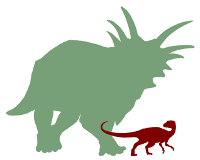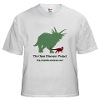By now, those of you who have been entering data from the literature — and maybe even more those who have been measuring bones themselves — will have noticed that it’s not quite as straightforward as it sounds. Some bones are crushed, distorted, broken, reconstructed, lost in soft peat for three months and recycled as firelighters. And what exactly is the “length” of a curved bone like the femur of many ornithopods? And where exactly is the “midshaft” that’s measured for the midshaft diameter? And so on.
We want to develop an explicit protocol for what bones are worth including, what measurements need taking and how they should be taken. But to do that, we’ll need your help. We want to know what issues you’ve come up against as you’ve worked on ODP data, so we can figure out standard answers. Post your questions as comments to this article: we’ll discuss them in the comments, and when we feel we have consensus, we’ll start to assemble a protocol document.
Our general feeling is that yes, there will be minor errors and distortions in the data, but there is no reason to suspect systematic bias and therefore not much to worry about (and not much we can do about it). Hopefully the database that we’re putting together will live forever and in the future people will revisit these specimens and submit “cleaned up” measurements in cases where that’s warranted. But that doesn’t mean we can’t be doing useful stuff in the meantime. It also doesn’t mean that we shouldn’t acknowledge these problems and fix them wherever possible.
So: (a) yes, crushing, distortion, reconstruction, measurement conventions, etc. are all valid concerns; (b) we will strive to overcome them to the extent possible, both immediately for the first paper and ultimately for the evolving database; but (c) these problems plague any large quantitative study of morphology — the only difference with the ODP is that those problems are out in the open; and (d) we don’t anticipate systematic bias and don’t think these problems are serious enough to prevent us from doing useful work right now.
Right then: questions, please!




My only concern is one that I feel must be cleared up. I mean, I request more information so I can contribute. I feel Andy Farke didn’t give me a clear explanation of this project. If you could please do so, that would be greatly appreciated. 😛
One other question (well, sensu lato): some museums give the whole dinosaur specimen a single catalog number while others give each bone element its own catalog number. This has generated some confusion while I am entering the column for specimen number.
Send me a direct email (andrew.farke@gmail.com) and I’ll see what I can do to get you on the right track. As pointed out elsewhere, the FAQ’s and How-To Guide should explain most of the project.
Hmm. . .good point. Maybe include a note listing all of the specimen numbers from a single individual? The only thing we’ll have to be careful of is where there are multiple size-similar individuals catalogued under the same or similar numbers. . .
That is exactly the problem when I was verifying the Hunt et Lehman (2008) paper yesterday, Andy – did you read my e-mail sent to you last night? Thanks!
Just replied to your email Leo! Re: the Hunt & Lehman paper, ReBecca Hunt herself will be providing some original measurements from the specimens, that will hopefully clear up any confusion.
I would also add, for those who are curious, that this is laying the groundwork for writing the paper(s) resulting from the ODP. . .these are the sorts of questions we anticipate reviewers might ask!
Thanks! Just wondering how many original authors are as kind as ReBecca… to confirm their data for us 🙂
Pingback: Update Your Spreadsheets! « The Open Dinosaur Project
I have a question: what if the paper is regarding, not a specimen but, a dinosaur family. What specimen number should we mention regarding the limbs measurements referred on the paper?
Henrique, if the paper gives a specimen number, then we can use the measurements: just give the family name, or whatever the paper has, in place of the genus. But a paper that says “a labeosaurine tibia was 56 cm long” without giving a specimen number is, unfortunately, no use.
Andy, if someone scours a paper for measurements but finds none, is it worth their letting you know? Then we could post that reference in a Don’t Bother page.
I see… but what if the paper gives measurements of certain species but don’t specify the specimen number?
And Mike Taylor’s idea sounds about great. I myself have a few checked papers with non-measurements.
I’d like to get Andy’s and Matt’s thoughts on this, too, but it seems to me that we’re not so hard up for data that we need to go scrabbling around with specimens whose number is not given, and which may therefore not even be accessioned.